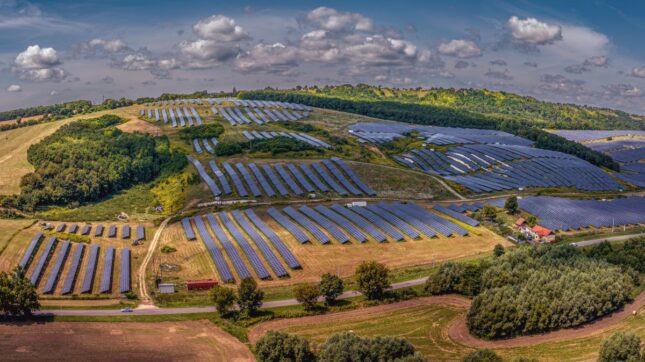-
The Global Energy Transition Is About Securing the Future, Not Managing Decline
November 5, 2025 By Lauren Herzer RisiThe global energy transition is often framed as a balancing act between climate commitments on one hand, and sufficient energy and economic security on the other. That framing assumes the transition will mean less: less energy, less growth, and a steady decline in fossil fuel use. But this rhetoric is, as Ambassador Anthony Agotha put it at last month’s Berlin Climate Security Conference a “false choice.”The reality is far more complex — and far more uneven across countries and regions. The question isn’t whether the transition will happen, but whether it will happen everywhere, in time, and in ways that foster stability and economic opportunity.
Building Partnerships to Unlock Economic Opportunities
For many low- and middle-income countries, the challenge isn’t a lack of climate ambition — it’s a lack of energy access. Globally, there are about 750 million people who still lack steady and reliable electricity.
Nowhere is this more evident than in sub-Saharan Africa, where about half of the population — an estimated 600 million people — lack access to electricity. Now, consider the pace of growing demand in the region, whose population is projected to nearly double by 2050, from 1.3 billion to 2.1 billion. In Somalia, for example, where only 50% of the population currently has access to electricity (just 24% in rural areas), the population is expected to double from 19.7 to 38 million people over the same period.
For many low-income countries, the “energy transition” is not about decarbonization — it’s about unlocking enduring economic development opportunities by providing power to homes, businesses, schools, and hospitals. But expanding energy infrastructure while lowering emissions will require financial, technological, and political partnerships that prioritize energy access by de-risking investment and localizing clean energy technologies and jobs. Without partnerships that provide an on-ramp for countries to simultaneously grow their economies and expand access, the global transition will stall.
Flipping the Narrative on Decline
Discussions of climate ambition are often framed as being in tension with energy and economic security. But fossil fuel dependence — with its price volatility, supply disruptions, and concentrated control — is rarely the picture of stability.
The question is not whether countries can balance climate ambition with energy security — it’s whether they can afford not to. Done right (recognizing that there is a lot packed into those two small words), the energy transition can be a pathway to stronger economies, more stable societies, and more secure futures.
The economics of clean energy are shifting fast. In 2024, renewables met 83% of global increases in electricity demand, according to Ember, with solar generation up 33% and wind up 7%. Yet the benefits are not evenly distributed. China and India were largely responsible for those increases. The International Energy Agency reports that only 15% of global clean energy investment — about $2 trillion annually — has gone to the Global South (excluding China). Meeting global targets will require that share to rise five- to seven-fold by 2030, reaching $1.7 trillion per year.
Meanwhile, the economic toll of climate inaction is already staggering. Between 2014 and 2024, nearly 4,000 extreme weather events affected 1.6 billion people and cost the global economy an estimated $2 trillion. In just the past two years, global economic damages reached $451 billion — a 19% increase over the previous eight years. In some countries, a single disaster can erase more than a year of GDP.
Last year, in the United States alone, 27 weather and climate disasters led to the deaths of 568 people and cost more than $1 billion in damages, collectively totaling $182.7 billion — about 20% of the Department of Defense’s budget for that year.
In fragile and conflict-affected states, the consequences are even more devastating. In 2023, torrential rains from Storm Daniel — made 50% worse by climate change, according to research — caused two dams to burst in Libya, killing nearly 6,000 people. Years of underinvestment in water infrastructure and near-total dependence on oil exports left Libya’s economy both highly exposed and poorly equipped to adapt.
The assumption that the energy transition will mean a simple, linear decline in fossil fuel use is misleading. Global energy demand continues to rise, but again, the drivers of that demand vary widely. In industrialized countries, AI is driving an increase in power-hungry data centers. But for poorer countries — those least responsible for climate change — energy access remains essential to development and industrialization. For many of those countries, fossil fuels are a necessary part of the equation. The question, then, is not if they are used, but how — with what technologies, under what rules, and with what accountability. Framing the transition exclusively around fossil fuel decline risks alienating the very countries that must be part of it. A better narrative is one centered on diversification, modernization, and energy security — not scarcity.
Pathway Dependency
The success of the global transition depends on what the largest economies (and largest greenhouse gas emitters) do — and how consistently they do it. Last April, acting assistant secretary of international affairs at the U.S. Energy Department, Tommy Joyce, said that net-zero policies put the US at a disadvantage compared to China. “…There are no wind turbines without concessions to or coercion from China,” he said.
China’s control over critical minerals and clean energy supply chains gives it enormous leverage, but it didn’t get there on its own. China’s accelerated economic growth presented an existential challenge to global ambitions to rein in global warming. The first decade of the 2000s was marked by significant cooperation between the U.S. and China, including a US-China Clean Energy Research Center. But while China adopted large-scale, industrial policies to solidify its leadership on renewable energy and elevate its role on the global stage, policy vacillations and inconsistencies in the U.S. have created structural disadvantages that hobble U.S. innovation, industry, and market access.
And while climate ambition has grown since the 2015 Paris Agreement, global emissions have not yet begun to decline. Much of the growth comes from emerging economies that still lack the means to transition quickly. Africa, for example, holds 60% of the world’s best solar potential yet receives less than 2% of global clean energy investment.
The energy transition is not a zero-sum game. It is an opportunity — to expand access, build economies, and ensure a more secure and sustainable future. Getting there requires reframing the conversation from one of limits to one of possibility, grounded in partnerships and a broader and longer-term perspective.
Lauren Risi is a Senior Fellow and the Director of the Stimson Center’s Environmental Security Program. She is also the Managing Editor of New Security Beat.
Editors note: This article originally appeared as a Stimson Center Commentary.
Sources: African Development Bank Group; BBC; Ember; International Chamber of Commerce; International Energy Agency; Politico; Reuters; United Nations; Wilson Center; World Population Review
 A Publication of the Stimson Center.
A Publication of the Stimson Center.








